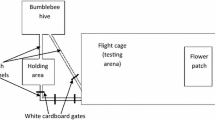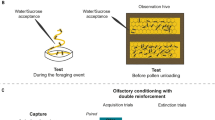Abstract
We trained worker bumblebees to discriminate arrays of artificial nectaries (one, two, and three microcentrifuge tubes inserted into artificial flowers) from which they could forage in association with their location in a three-compartmental maze. Additionally, we challenged bees to learn to accomplish three different tasks in a fixed sequence during foraging. To enter the main three-compartmented foraging arena, they had first to slide open doors in an entry box to be able to proceed to an artificial flower patch in the main arena where they had to lift covers to the artificial nectaries from which they then fed. Then, the bees had to return to the entrance way to their hive, but to actually enter, were challenged to rotate a vertically oriented disc to expose the entry hole. The bees were adept at associating the array of nectaries with their position in the compartmental maze (one nectary in compartment one, two in two, and three in three), taking about six trials to arrive at almost error-free foraging. Over all it took the bees three days of shaping to become more or less error free at the multi-step suite of sequential task performances. Thus, they had learned where they were in the chain sequence, which array and in which compartment was rewarding, how to get to the rewarding array in the appropriate compartment, and finally how to return as directly as possible to their hive entrance, open the entrance, and re-enter the hive. Our experiments were not designed to determine the specific nature of the cues the bees used, but our results strongly suggest that the tested bees developed a sense of subgoals that needed to be achieved by recognizing the array of elements in a pattern and possibly chain learning in order to achieve the ultimate goal of successfully foraging and returning to their colony. Our results also indicate that the bees had organized their learning by a hierarchy as evidenced by their proceeding to completion of the ultimate goal without reversing their foraging paths so as to return to the colony without food.




Similar content being viewed by others
References
Balleine BW, Garner C, Gonzalez F, Dickinson A (1995) Motivational control of heterogeneous instrumental chains. J Exp Psychol: Anim Behav Proc 21:203–217
Bar-Shai N, Keasar T, Shmida A (2011a) How do solitary bees forage in patches with a fixed number of food items? Anim Behav 82:1367–1372
Bar-Shai N, Keasar T, Shmida A (2011b) The use of numerical information by bees in foraging tasks. Behav Ecol 22:317–325
Birch H (1945) The relation of previous experience to insightful problem-solving. J Comp Psychol 38:367–383. doi:10.1037/h0056104
Bitterman ME (1984) Migration and learning in fishes. In: McCleave ID, Arnold GP, Dodson II, Neill WH (eds) Mechanisms of migration in fishes. Plenum, New York, pp 397–420
Born DG, Snow ME, Herbert EW (1969) Conditional discrimination learning in the pigeon. J Exp Anal Behav 12:119–125
Byrne R, Byrne A (1993) Complex leaf-gathering skills of mountain gorillas (Gorilla g. berengei): variability and standardisation. Am J Primatol 31:521–546
Byrne R, Russon A (1998) Learning by imitation: a hierarchical approach. Behav Brain Sci 21:667–721. doi:10.1017/S0140525X98001745
Carter DE, Werner TJ (1978) Complex learning and information processing by pigeons: a critical analysis. J Exp Anal Behav 29:565–601
Chameron S, Schatz B, Pastergue-Ruiz I, Beugnon G, Collett TS (1998) The learning of a sequence of visual patterns by the ant Cataglyphis cursor. Proc R Soc Lond B 265:2309–2313
Chittka L, Geiger K (1995) Can honeybees count landmarks? Anim Behav 49:159–164
Chittka L, Thomson JD (1996) The ecology of bumble bees in T-mazes. In: Elsner N, Schnitzler H (eds) Göttingen Neurobiol Rep., Thieme, Stuttgart, p 130
Collett TS, Fry SN, Wehner R (1993) Sequence learning by honeybees. J Comp Physiol A 172:693–706
Couvillon PA, Biiterman ME (1988) Compound-component and conditional discrimination of colors and odors by honeybees: further tests of a continuity model. Anim Learn Behav 16:67–74
Couvillon PA, Bitterman ME (1989) Reciprocal overshadowing in the discrimination of color–odor compounds by honeybees: further tests of a continuity model. Anim Learn Behav 17:213–222
Couvillon PA, Bitterman ME (1991) How honeybees make choices. In: Goodman JL, Fischer RC (eds) The behaviour and physiology of bees. CAB International, Wallingford, pp 116–130
Dacke M, Srinivasan MV (2008) Evidence for counting in insects. Anim Cogn 11:683–689
Dehaene S (1999) The number sense: how the mind creates mathematics. Oxford University Press, Oxford
Delaney PF, Reder LM, Staszewski JJ, Ritter FE (1998) The strategy specific nature of improvement: the power law applies by strategy within task. Psychol Sci 9(1):1–8
Döhl J (1968) Über die Fähigkeit einer Schimpansin Umwege mit selbstständigen Zwischenzielen zu überblicken (the ability of a female chimpanzee to overlook intermediate goals). Z Tierpsychol 25:89–103
Domjan M (2015) The principles of learning and behavior, 7th edn. Cengage Learning, Stamford
Epstein R (1987) The spontaneous interconnection of four repertoires of behavior in a pigeon (Columba livida). J Comp Psychol 101:197–201
Epstein R, Kirshnit CE, Lanza RP, Rubin LC (1984) ‘Insight’ in the pigeon: antecedents and determinants of an intelligent performance. Nature 308:61–62. doi:10.1038/308061a0
Funayama ES, Couvillon PA, Bitterman ME (1995) Compound conditioning in honeybees: blocking tests of the independence assumption. Anim Learn Behav 23:429–437
Gegear RJ, Laverty TM (1995) Effect of flower complexity on relearning flower-handling skills in bumble bees. Can J Zool 73:2052–2058
Gegear RJ, Laverty TM (1998) How many flower types can bumblebees work at the same time? Can J Zool 76:1358–1365
Giurfa M, Núñez JA (1992) Honeybees mark with scent and reject recently visited flowers. Oecologia 89:113–117
Giurfa M, Núñez JA (1993) Visual modulation of a scent-marking activity in the honeybee, Apis mellifera L. Naturwissenschaften 80:376–379
Grasso FW, Basil JA (2009) The evolution of flexible behavioral repertoires in cephalopod mollusks. Brain Behav Evol 74:231–245
Gross HJ, Pahl M, Si A, Zhu H, Tautz J, Zhang S (2009) Number based visual generalisation in the honeybee. PLoSONE 4(1):e4263. doi:10.1371/journal.pone.0004263
Heathcote A, Brown S, Mewhort DJK (2000) The power law repealed: the case for an exponential law of practice. Psychonom Bull Rev 7(2):185–207
Heinrich B (1979) “Majoring” and “minoring” in bumblebees: an experimental analysis. Ecology 60:245–255
James W (1890) The principles of psychology. Macmillan & Co., London
Karban R, Black CA, Weinbaum SA (2000) How 17-year cicadas keep track of time. Ecol Lett 3:253–256
Kohler W (1925) The mentality of apes. 2nd ed. Harcourt, Brace & Co., New York (transl. from German by E. Winter)
Lashlev KS (1938) Conditional reactions in the rat. J Psychol 6:311–324
Leppik EE (1953) The ability of insects to distinguish numbers. Amer Nat 87:229–236
Mackintosh NJ (1974) Psychology of animal learning. Academic Press, USA
Martin H (1965) Leistungen des topochemischen sinnes bei der Honigbiene. Z vergl Physiol 50:254–292
Menzel R (1990) Learning, memory and ‘cognition’ in honey bees. In: Kesner RP, Olten DS (eds) Neurobiology of comparative cognition. Erlbaum Inc., Hillsdale, pp 237–292
Mirwan HB, Kevan PG (2014) Problem solving by worker bumblebees Bombus impatiens (Hymenoptera: Apoidea). Anim Cogn 17:1053–1061. doi:10.1007/s10071-014-0737-0
Mirwan HB, Kevan PG (2015) Maze learning and route memorization by worker bumblebees (Bombus impatiens Cresson (Hymenoptera: Apidae)). J Insect Behav 28:345–357
Mostofsky DI (1965) Stimulus generalization. Stanford University Press, Stanford
Newell A, Rosenbloom PS (1981) Mechanisms of skill acquisition and the law of practice. In: Anderson JR (ed) Cognitive skills and their acquisition. Erlbaum Inc., Hillsdale, pp 1–55
North AI, Maller O, Hughes C (1958) Conditional discrimination and stimulus patterning. J Comp Physiol Psychol 51:711–715
Pahl M, Si A, Zhang S (2013) Numerical cognition in bees and other insects. Front Psychol 4:1–9. doi:10.3389/fpsyg.2013.00162
Pearce JM (2008) Animal learning and cognition: an introduction. Psychology Press, Amsterdam
Ritter FE, Schooler LJ (2002) The learning curve. In: International encyclopedia of the social and behavioral sciences. Pergamon Press, Amsterdam, pp 8602–8605. http://www.iesbs.com/
Saavedra MA (1975) Pavlovian compound conditioning in the rabbit. Learn Motiv 6:314–326
Schrier AM, Thompson CR (1980) Conditional discrimination learning: a critique and amplification. J Exp Anal Behav 33:291–298
Skinner BF (1938) The behavior of organisms: AN experimental analysis. Appleton-Century-Crofts, New York
Skinner BF (1953) Science and human behavior. The Macmillan Co., New York
Smith MP (1951) The stimulus-trace gradient in visual discrimination learning. J Comp Physiol Psych 44:154–161
Spiegel R, McLaren IPL (2006) Associative sequence learning in humans. J Exp Psychol: Anim Behav Proc 32:156–163
Sun R (2001) Introduction to sequence learning: sequence learning. Lecture notes in computer science. Comput Sci 1828/2001
Sun R, Giles CL (2001) Sequence learning: from recognition and prediction to sequential decision making. IEEE Intelligent Systs Their Appl 16(4):2–5
Taylor AH, Elliffe D, Hunt GR, Gray RD (2010) Complex cognition and behavioural innovation in New Caledonian crows. Proc R Soc B 277:2637–2643
Terrace HS (1987) Chunking by a pigeon in a serial learning task. Nature 325:149–151
Terrace HS (1991) Chunking during serial learning by a pigeon: I. Basic evidence. J Exp Psychol: Anim Behav Proc 17:81–93
Thomas DR, Curran PJ, Russell RJ (1988) Factors affecting conditional discrimination learning by pigeons: II. Physical and temporal characteristics of stimuli. Anim Learn Behav 6:468–476
Weisman RG, Dodd PWD, Wasserman EA, Larew MB (1980) Representation and retention of two-event sequences in pigeons. J Exp Psychol: Anim Behav Proc 6:312–325
Acknowledgments
We thank the Canadian Pollination Initiative (NSERC-CANPOLIN for which this is publication No. 135) for funding some of this research reported. HM thanks the Libyan Ministry of Education and Canadian Bureau for International Students for scholarships received. BioBest Biological Systems, Leamington, Ontario, kindly provided colonies of the test subjects. We are especially grateful to Drs T. Woodcock and Francesco Leri, CANPOLIN, and Psychology Department, respectively, of the University of Guelph for critical reviews and help in preparing this paper. The studies reported herein comply with Canadian ethical standards, and those of the University of Guelph, for research and treatment of experimental animals
Author information
Authors and Affiliations
Corresponding author
Ethics declarations
Conflict of interest
There is no conflict of interest with any of the sponsors of the research reported herein.
Rights and permissions
About this article
Cite this article
Mirwan, H.B., Kevan, P.G. Conditional discrimination and response chains by worker bumblebees (Bombus impatiens Cresson, Hymenoptera: Apidae). Anim Cogn 18, 1143–1154 (2015). https://doi.org/10.1007/s10071-015-0887-8
Received:
Revised:
Accepted:
Published:
Issue Date:
DOI: https://doi.org/10.1007/s10071-015-0887-8




